Faigie Libman
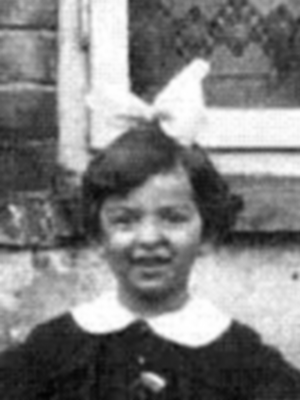
Born: Kovno (Kaunas), Lithuania, 1934
Wartime experience: Ghetto and camps
Writing partner: Farla Klaiman
Faigie Schmidt Libman was born in Kovno (Kaunas), Lithuania, in 1934. After the Nazi occupation of Lithuania in June 1941, she and her family were forced into the Kovno ghetto in the suburb of Slobodka.
When the ghetto was liquidated in July 1944, she was taken with her family by cattle car to the Stutthof concentration camp. From there, her father was sent to the Dachau concentration camp. In Stutthof, Faigie dug trenches while her mother worked as a nurse. They were later sent to three small forced labour camps: Trunz, Merzen and Lubicz. They were forced on a death march from Lubicz and were liberated near Danzig (now Gdańsk, Poland) on January 21, 1945, by Soviet soldiers. Faigie’s father did not survive. Faigie and her mother were in a displaced persons (DP) camp in Austria until 1948, when they were able to immigrate to Montreal. Faigie married Benny Libman in 1954 and they raised a family, moving to Toronto in 1972. Faigie worked in early childhood education until her retirement, and she has been involved in Holocaust education since 1989.
Life of Culture in Kovno
Kovno (Kaunas), Lithuania, was a very cosmopolitan city, and so was Vilnius. Kovno was initially the capital; nowadays it’s Vilnius. There was competition between the two cities, like Montreal and Toronto with hockey, but there it was about who was more learned. People used to come from all over the world to study in Lithuania. In Slobodka, a run-down suburb where the ghetto would be established, there was a yeshiva, the Slobodka Yeshiva, which was transplanted to Israel and still exists there.
My father was a very prominent person, an intellectual who spoke five languages. He had an international bookstore, a mokslo knygynas (science bookstore), on a prominent street, Laisvės alėja (Liberty Avenue), like Sainte-Catherine Street in Montreal or Bloor Street in Toronto. He had gone to university and travelled all over the world; I have a picture of him in Mexico City in 1926. Then he came back to Lithuania and met my mother. My mother was born in the small town of Krakinova (now Krekenava), where there was no high school or university. She went to the city of Ponevezh (Panevėžys) to study in high school, but she wanted to be a nurse. Can you imagine that in the late 1920s — she was born in 1912, so she was about sixteen — she persuaded her parents to let her go to the big city to study nursing? It boggles the mind, since there was no communication like there is today, not many telephones. My grandfather went with her to Kovno and got her a place to stay at a Jewish home. She studied nursing and graduated as a surgical nurse. At university she met my father, and in January 1931 they married.
I was their only child, born in July 1934. My mother gave birth when she was already a nurse, when she had a very good job.
I think I was the only grandchild on my father’s side and the youngest one on my mother’s side, so I was doted upon. I loved my mother, but I was a little bit afraid of her. My mother was the ruler. My father was a wonderful gentleman, and I went with him to birthday parties and to the museum. When I was six years old, I saw the opera Aida with my father. His store was my haven, and I learned how to read and write before any of my friends because of him. My father was my life — he took me everywhere, showed me a lot of culture and was my very best friend.
I had a Russian governess and can speak Russian because of her. We also had a maid come in to clean. I had somebody who made my clothes, which were copies of clothes from Paris. I had a black seal coat with a hat and a muff to match. I have a few pictures that my aunt sent, where my mother and I are wearing matching clothes. In the photos, I always have a bow in my hair, and my mother always dressed me in short little dresses because I had very nice pulkes (thighs). When she got her vacation time, we used to go to Krakinova in July for my birthday to visit her parents and for her to show me off. Krakinova was far away, so we spent a lot of time there in the summer. That’s where I really connected with my mother. I remember going to Palanga on the Baltic Sea and my mother holding me as hail was coming down. We used to go to Memel (Klaipėda) as well, also by the Baltic Sea, where we had a very good time together. Otherwise, I don’t remember spending a lot of time with her. But during the war, my mother and I were very close; it was lucky my mother had me and I had my mother.
***
Although the war started in 1939 in Poland, the Nazis didn’t come to Lithuania until 1941. My earliest memory of school is from 1940. I may have started kindergarten in 1939, but I remember the year 1940 because the Soviet Union invaded Lithuania.
I remember Grade 1 and joining a choir — I think that’s when my love for singing really grew. I had friends and I loved learning. We used to play hopscotch, and I was very tall for my age so I was often the leader. I would lead my friends in singing because some of them were a little bit younger, so I used to teach them Russian and Yiddish songs. I was always singing and telling meiselach, stories, that I learned at my father’s store. I remember reading to them; now that I think back, maybe that started my wanting to be a teacher. I would sort of lord it over my friends. I was a little show-offy because I could read, I could tell meiselach, and I had a Shirley Temple doll. I was the centre of attraction.
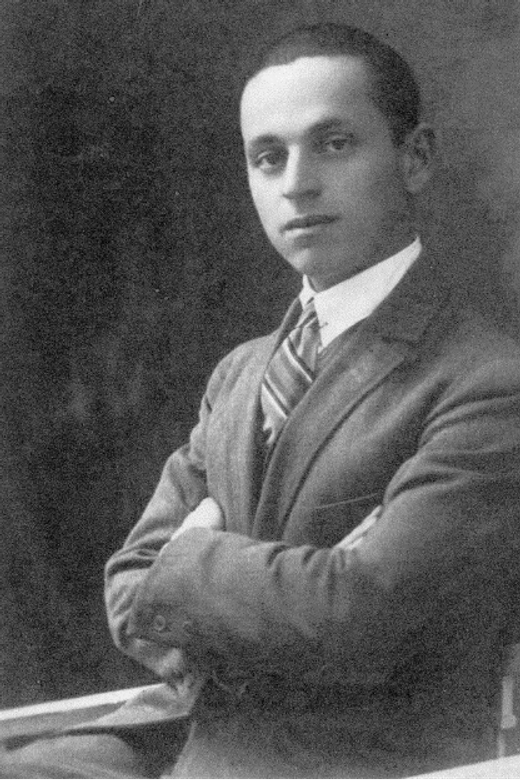
Faigie's father, Philip (Faiva) Schmidt. Kovno, Lithuania, 1925.
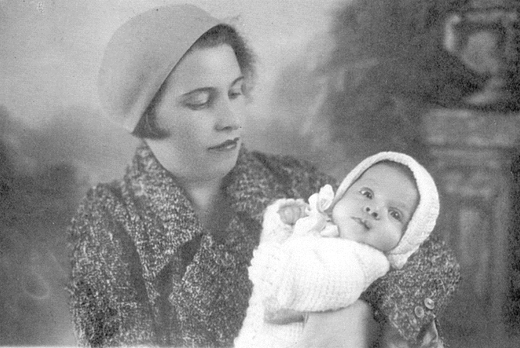
Faigie with her mother, Batia. Kovno, 1935.
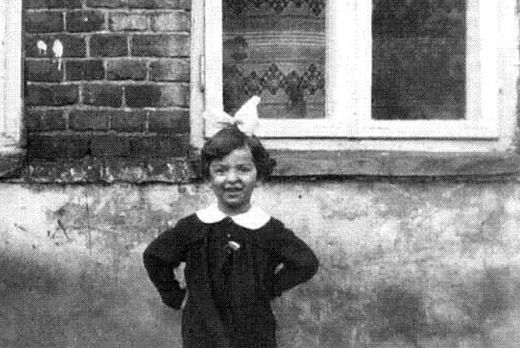
Faigie, likely while on vacation visiting her grandparents. Krakinova (Krekenava), Lithuania, circa 1940.
The Memory of the Wailing
As a surgical nurse, my mother was mobilized for the war, and I remember her taking my father and me to the hospital where she worked. I was a cute little kid, so I would go to see adults or children who were hurt to sing a song and cheer them up. While the bombs were falling, we lived in the hospital, sleeping there and eating there while my mother was working. I was nearly seven; this was the first time I saw her in action, and my respect for my mother after that stay in the hospital completely changed. She must have brought us food or made sure my father and I were looked after, but she left me with my father, and I didn’t see her and don’t remember being hugged by her or anything. I don’t remember her stopping — she worked around the clock for days to help people. That was her nature.
When things quieted down, we went back home, but then came the proclamations from the Nazi authorities. I don’t remember how many days we were given, but the Kovno ghetto was formed in Slobodka right away, and we were ordered to leave our home and find a place there. There was such turmoil as people moved — naturally there were no trucks for moving belongings; I have a picture from Yad Vashem where you could see wheelbarrows, suitcases, and people milling around. The houses in the ghetto were very, very crowded, with four or five families forced to live together. We were with my father’s parents and his sister as a family then.
October 28, 1941. That day, there was an order that all the Jews had to line up with their families, even those who were too sick to stand or walk had to be taken out on a chair or in a bed. We were told that the Nazis were going to take a census and that we’d be counted to see how many people were still in the ghetto so they could give us more food. Between June and October 1941, people had been sent to work detail or had died or been murdered, so they wanted to know who was left.
I remember walking with my parents and having a stomach ache because I felt like something was happening. I went to the bathroom and then lined up with my family right away. We looked very respectable. I remember the multitudes marching into Democracy Square and Helmut Rauca, yemach sh’mo (may his name be wiped out), standing on a mount with a dog, holding a whip and wearing white gloves. To this day, I don’t own a pair of white gloves. And as we marched in front of him.... It was so methodical. Without rhyme or reason, my paternal grandfather and my aunt Chava, the university student, were sent to a different side. Before that moment, we had always been together. They were sent to one side and we were sent to the other.
***
We found out later on what happened. I remember my mother telling the story, heard from a young man who escaped from the open pits, where bodies were on top of him. Helmut Rauca, yemach sh’mo, was responsible for having pits dug at the Ninth Fort and 9,200 Jews were killed in them, shot to death.
After what became known to us as the “Great Aktion,” we went back to the ghetto. The Nazis needed workers, and we — me, my mother, my father and my grandmother — were taken to our very first Gefangenenlager (prison labour camp) to build the aerodrome, where the planes were. My mother, father and all my friends’ fathers were taken to work very early every morning in a truck, and my grandmother and my friends and I were left there in the camp. My mother worked as a nurse, taking her supplies in a basket to treat workers who got hurt, and she would come back very late at night.
One night, we were given permission to have a little singsong. It was some time in the early spring of 1944. Early the next morning, my mother shook me awake; she had permission to take me with her to work. I told her that I was very hungry and tired because the night before we sang some songs to cheer people up, so I had been up late. Also, in a labour camp we couldn’t find food as we had before in the ghetto, and we had to rely on whatever we were given. My mother said, “I have permission. You’re coming to work with me.” I was crying, “I am tired. I can’t.” And she told me, “Papa would want you to come along.” So I went with my mother, in the cabin of the truck with the men. I spent the whole day with her and I remember seeing how she was fixing people. If a worker was hurt or got a cut, my mother’s job was to help, and it was a big thing that she had a job.
When we got back late that night, I will never forget what happened. I will never forget the wailing. Trucks had come into the labour camp and collected all the children and the old people. The Nazis came in trucks and took all the children, and we found out later on that they were either killed that day or taken to Auschwitz. I was the last, the only, child in that labour camp as far as I know. I was so upset that I broke my Shirley Temple doll to smithereens. I will never forget that as long as I live. I remember the wailing — now that I sleep alone, I can even hear it in my head — and the turmoil, the crying. I don’t remember the adults going back to work; I remember this horrible scene as we were all taken back into the ghetto. I still had a mother and a father, but my grandmother and all my friends were taken away.
***
In 1944, the Allies were coming closer, which I remember very well because my life changed an awful lot. My tenth birthday was in July 1944, so I remember that the ghetto was liquidated then. Only my mother, my father, and I were left from our family. There were proclamations again with the pretext that we’d be taken to somewhere better and we’d have more food. Then, we were loaded onto the cattle cars. I remember the degradation in the cattle cars — no water and having to go to the bathroom and my mother standing over me; you went wherever you were. I don’t know how we didn’t go crazy. I know people committed suicide because they couldn’t take it and there was too much uncertainty, too much hunger; you had to be alert every moment. Those cattle cars were unbearably dehumanizing. When the doors were opened up, a lot of people hadn’t made it. Surviving was a miracle.
We were in the cattle cars for a few days, travelling from Lithuania into Poland, near Danzig. When the doors were opened, we were in the Stutthof concentration camp. The men were able-bodied and could work, so they were taken to Dachau as workers.
***
From Stutthof we went to three small forced labour camps — Trunz, Merzen and Lubicz. We were in each of the little camps for short periods of time. We lived in tents and slept on straw and used toilets that were holes in the ground surrounded by wood, which was all meant to degrade and humiliate us.
In late winter of 1944, after the ground froze, we were sent on a death march from the last camp, Lubicz, until we were liberated on January 21, 1945. The marching was horrendous, and a lot of people died. My mother later told me that she put my shoes in her bosom to warm them. She said some women were hugging and kissing their young daughters but she didn’t remember hugging or kissing me, only pushing me onward so that I wouldn’t fall down because if you fell down you were finished. Falling meant you couldn’t walk and you were left for dead. I found out later on that my father was killed, but my mother had me, and keeping me going helped her to keep going. I don’t think my mother ever slept; she was always looking after somebody who was hurt and needed her help.
When we got back late that night, I will never forget what happened. I will never forget the wailing. Trucks had come into the labour camp and collected all the children and the old people.
Freedom to Speak Out
We were liberated near Danzig, in a forest where we were staying in abandoned huts. My mother wrote that on the march, we were in huts and they were going to bomb the huts. I don’t remember about the bombs, but I do remember running from the huts to a big building where we stayed overnight. The next morning, we were liberated by the Soviets. My mother wrote beautifully about the war and our liberation. This excerpt is from my mother’s diary:
In January 1945 our guards started to feel a bit uneasy. Allied planes flew over us. We also heard shooting from the distance. We found out from our guards that the Russians are pressing forward. What good music this was to our ears. Suddenly our guards receive orders to move our camp further away from the front lines. We march 50 kilometres in the rain, wind and sleet. One day we were led into a camp to stay overnight. Later we found out that we were supposed to have been gassed there, but somehow the orders were not confirmed as the Nazis were too confused from the pressing Allied advances. A whole day we march till we reached a forest. Deep in the forest we found abandoned huts. We were very happy to find any place to put our weary heads down, no matter what happens.
That night, all that I have lived through was vivid in my mind. Is it true that my little girl is still with me? How quiet and peaceful everything is here; the snow covers everything, we are like a part of the bushes and broken down trees that protrude through the snow. The spruces and pine trees stand proudly covered with their evergreen branches. It appears to me that they hold themselves aloof, being afraid of the armed two-legged animals. In the morning the confused SS guards did not know what to do with us. They laid mines all around the huts, in order to get rid of us. They never could fulfill this order as more and more shooting was heard. A loud shrill pierced the forest, that was the signal for our guards to abandon us. They left immediately, and in all the confusion we thank God we’re forgotten, we were left alone.
We were taken to the American zone, to Bad Gastein, near Salzburg, Austria. We lived in a room in Bad Gastein and were given clothes. Naturally, my mother went to work right away in the infirmary; there’s a picture of my mother dressed in a nurse’s uniform.
We filled out immigration papers for South Africa, where my mother’s brother, Max, lived, and for New Rochelle, New York, where Tante (Auntie) Sadie lived, and Montreal, where Tante Nechama lived. The papers to Canada came through first. Nechama’s husband, Morris, did his utmost to bring us to Montreal. Uncle Morris and Tante Nechama had come to Canada way before and their daughter, Anita, was born in 1931. My mother had given them the money, 500 litai, to travel, and Morris told us how hard he worked at bringing us. You couldn’t leave the camps unless somebody sponsored you. Rothschild and some others gave money to bring orphans, but otherwise you stayed in the displaced persons (DP) camps from 1945 to 1948. Uncle Morris said we came on beer because he owned a grocery store in NDG (Notre Dame de Grâce, a Montreal neighbourhood) and would give a case of beer or schnapps for Christmas to any official he could find who might be able to help, and he took them out for dinner. It still took three years. We arrived in Halifax on the Nea Hellas and came to Montreal in March 1948.
***
In 1982, I came home from school and opened up the Toronto Star to see an article with the headline, “North York man charged with Nazi war crimes by West Germany.” The article said the man, Helmut Rauca, lived on Otonabee Avenue, which was just east of Newtonbrook High School, and I lived just west of there on Fontainbleau Drive. So he had actually been my neighbour for forty-one years. I still get goosebumps thinking about it. It said in the newspaper that he was charged with taking part in the massacre of thousands of Jews in Kaunas, Lithuania. Can you imagine how I felt? Everything that I tried to hide for so many years came back. I called my supervisor and I said that I didn’t think I could come into school the next day. She said, “Faigie, what’s wrong?” I never missed school unless I was really sick, I loved teaching so much, but this completely threw me off. I remembered Rauca very vividly, since I saw him face-to-face. What shook me up more was when I found out where he lived, and his neighbour said, “What do you want from him? He is such a nice man. He plays classical music.” The only Nazi ever, to this day, as we’re going into 2013, to be extradited from Canada. Rauca died in jail. It boggles the mind! I have documentation about his trial in Germany. And this is why I began to tell my story.
It was in 1989 that I first started to speak out a little about what we went through, though I started doing more of it after retirement. The Anne Frank Exhibit was showing in 1989 at Ontario Place, and survivors were needed to speak. My friend Gloria put my name down and said, “Faigie, you’re going to tell your story.” I said, “What am I going to do with the school, with the kids?” She said, “They’ll find a supply.” I went to speak, and a priest hugged me, which I’ll never forget. I spoke for fifteen minutes, and I still have the sash I was given to wear. Before that, though everybody knew that I came from Lithuania, they didn’t know my story of survival. My daughter, Ann, my son Lenny, and Lenny’s girlfriend, Debbie, came to hear me and they were inconsolable, my daughter especially. They said, “How come you never told us?” Benny was such a wonderful husband, and I don’t know why I hadn’t told him either.
I’ve also had so many wonderful experiences as a speaker in Holocaust education. I’ve spoken for the Toronto Holocaust Centre (now the Toronto Holocaust Museum), the Simon Wiesenthal Centre, the Canadian Centre for Diversity, and the Dominion Institute, though the Dominion Institute is not sending me to speak that much. My main ones are the Holocaust and the Simon Wiesenthal Centres. I love them both and they send me to different schools to speak. I also went to McMaster and to Western and to Queen’s, where they wrote in their newspaper about me.
I seem to connect to young people. I love to go to the non-Jewish schools, the Catholic schools in Woodbridge. The girls come after I speak to hug me, and then the boys line up quietly to hug me, too, and the Grade 12 boys are taller than me. One teacher stood up afterward to ask, “How can you be so positive after what happened to you?” I speak about my nature, that I am an optimist and used to tell my friends, “Don’t worry, it will be good; God will help.” I talk about bullying and how wonderful my teacher in Grade 7 was, how teachers are so important and should be elevated. I tell them what hate did and that it doesn’t matter if they pray in a synagogue or a mosque or a church or don’t pray at all — they’re the future and we rely on them. I tell them that there is beauty and goodness in everybody and they have to be nice to each other, and they have to be the leaders.
When we were in the ghetto, I would ask my father, “Isn’t there anybody who can help us?” So after the war, when I found out that there were people who risked their lives to save Jews, I wanted to find out about them, the Righteous Among the Nations. I can’t speak about all of them when I speak to young people, but I speak about a few; people have to know that there were those who risked their life to save somebody else.
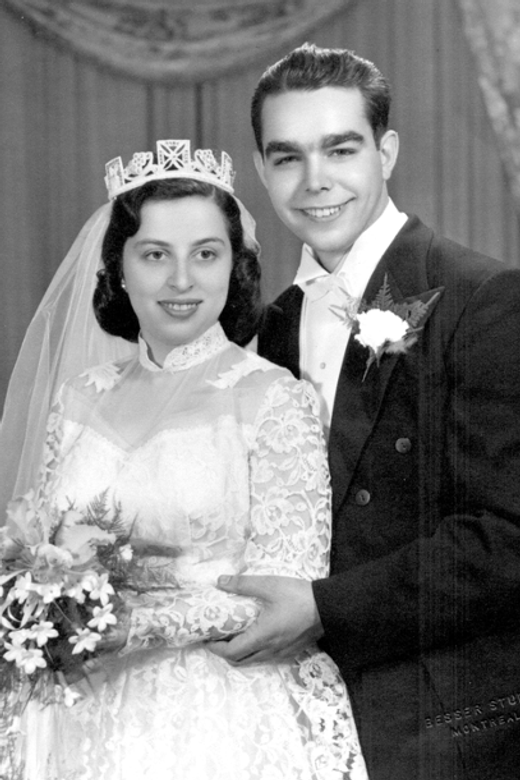
Faigie and Benny Libman at their wedding. Montreal, June 1954.
Faigie and her Sustaining Memories writing partner, Farla Klaiman. Toronto, 2013.

